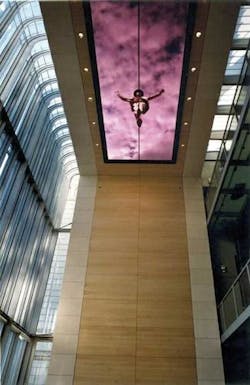LIGHT-EMITTING DIODES: LED markets grow, particularly in Asia

Last year brought continued strong growth (an almost 50% average annual growth rate since 1995) for the high-brightness light-emitting-diode (LED) market, as evidenced by a record turnout of almost 350 attendees at the 2005 Strategies in Light Conference (Strategies Unlimited; Mountain View, CA) last month.
Available figures for the worldwide market (not including high-brightness LEDs produced and sold within mainland China) indicated 37% growth in 2004 to reach almost $3.7 billion, according to Robert Steele, director of optoelectronics at Strategies Unlimited, who also ranked cumulative high-brightness-LED market growth since 1999 at an estimated two times greater than nontelecom laser diodes, about three times greater than silicon-semiconductor components, and more than an order of magnitude greater than the estimated growth of telecom-laser components.
More than half of the 2004 market growth was driven by mobile applications, almost all of which were keypad and display backlights in mobile phones. But the industry will need to fill new application growth areas in order to continue growth as the mobile-phone market saturates, Steele said. Promising application areas as well as various technical and market approaches to these applications were covered in depth during two full days of conference presentations and panel discussions.
Large displays
Sydney Chu, international business director of Cotco International (Hong Kong, China) spoke immediately after Steele’s introduction and discussed his company’s efforts in developing LEDs for backlighting large liquid-crystal-display (LCD) TV screens. Limitations to the current cold-cathode fluorescent-lamp (CCFL) technology include the lack of a cost-reduction strategy to help drive LCD-TV market penetration over the next few years; heat stress approaching critical levels; severe deterioration of chromaticity with age; failure to maintain brightness uniformity with screen enlargement; and increasing environmental concerns over mercury in CCFLs. Chu discussed high-brightness-LED solutions for all of the above concerns as well as significantly increasing LCD-TV lifetime-currently on the order of 60,000 hours and expected to exceed 60,000 hours as a minimum with LED illumination.
Tony Van de Ven, chief technology architect at Lighthouse Technologies (Hong Kong, China) followed Chu with a talk on the evolution of the full-color-LED-screen market for video advertising that has grown in a very short time from 56‑in. diagonals to full-building-sized displays (see figure).
“Electronic billboards have always been envisaged as the killer app, but costs need to come down first,” he said. Currently, nonmodular small screens from 2 to 8 m2 in surface area can cost up to $50,000. Larger electronic billboards with surface area on the order of 30 sm2 and higher resolution can cost up to $500,000. And the most spectacular, building-size displays, with the highest resolution and exceeding 200 m2, can cost more than $5 million.
As display sizes increase beyond 100-in. diagonals and 1000-nit (candela/m2) brightness, LEDs become the only technology capable of fitting all of the requirements. But in addition to continued cost reduction (LED prices are currently decreasing by about 20% a year, he said), other areas that need more work include maintaining high reliability over very high component counts; redundancy of power supplies and fans, which have relatively low mean times between failure; and development of diagnostics for remote sensing and autocorrection of problems caused by component failures.
Asian support
The fact that the two presentations following Steele’s conference-opening market review were from Asian companies was indicative not only of the significant Asian presence at the meeting but also the rapid growth of Asian markets as well as manufacturing capability in the high-brightness LED industry. This is partly because of government support, Steele said. The U.S. Department of Energy is funding solid-state-lighting research on a small scale while the U.S. Next Generation Lighting Initiative remains stalled in Congress. The Japanese national program has been under way since 1998, however, and new initiatives have begun in Taiwan, Korea, and China.
Ling Wu, director of the National Semiconductor Lighting Engineering Project Coordination and Management Office (Beijing, China) discussed China’s efforts, which are motivated primarily by desires to reduce fossil-fuel consumption and environmental pollution related to electricity production. Six national ministries and eleven local governments launched China’s solid-state-lighting program in June of 2003 with a $17 million investment from the central government to explore the market for LED-lighting applications and to promote development of Chinese industry.
In 2003, a total investment of about $725 million was made in China’s LED industry, which included more than 40,000 employees in more than 600 companies producing about 20 billion LEDs. That industry has grown from importing gallium nitride wafers and supplying 5% of the domestic market for blue chips in 2003 to domestically producing gallium nitride wafers and chips and supplying 20% of the domestic market for blue chips in 2004. Wu added that domestic industry growth is forecast to supply 40% to 50% of China’s market for blue chips in 2005.
“The combination of government plus private sector efforts could make China the largest market for solid-state lighting,” Steele said.
Hassaun A. Jones-Bey | Senior Editor and Freelance Writer
Hassaun A. Jones-Bey was a senior editor and then freelance writer for Laser Focus World.